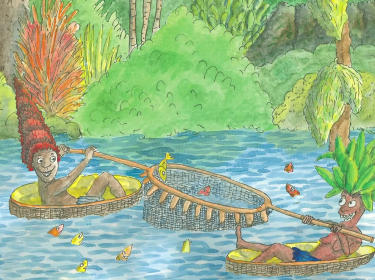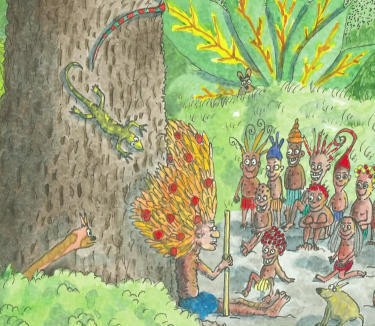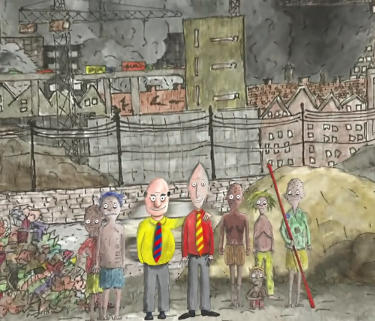Civilization Reduces Quality of Life
Jason Godesky / Tribe of Anthropik. Minor edits for readability by Stop Fossil Fuels.
#25 of Thirty Theses
Republished in accordance with Creative Commons Attribution 3.0 License
Nothing in human existence has had a more profoundly negative impact on our quality of life than civilization. As we have already seen, it introduced the unnecessary evil of hierarchy (see thesis #11); it introduced the difficult, dangerous, and unhealthy agricultural lifestyle (see thesis #9); it makes us sick (see thesis #21), but provides no better medicine to counterbalance that effect (see thesis #22). It introduced endemic levels of stress, a diet and lifestyle maladapted and deleterious to our health, war as we know it, and ecological disaster, but it has given us nothing to counterbalance those effects; it has no monopoly on medicine, or knowledge in general (see thesis #23), or even art (see thesis #24), making the overall impact of civilization on quality of life disastrous.

Measuring quality of life is always a tricky thing, but the United Nations’ “Human Development Index” (HDI) looks at three criteria: longevity, knowledge, and standard of living. In the case of the HDI, all three are measured in ways biased towards civilization. For example, longevity is measured by life expectancy at birth—a measure which presumes the common civilized assumption that life begins at birth. It does not weight the average with abortions, for example, even though there is disagreement even within our own culture of when life begins. Given such disagreement, we should not be terribly surprised to learn that other cultures have different measures of when life begins. Foraging cultures, for example, often believe that life begins at age two, and thus classify infanticide and abortion in the same category. Children are often not named or considered persons until that time. A !Kung woman goes into labor, and walks into the bush—maybe she comes back with a baby, and maybe she doesn’t. Whether stillborn or killed at birth, it’s not considered any business of anyone else’s. This kind of attitude has given foragers a very high infant mortality rate, leading many naive commentators to assume that their way of life must be terribly afflicted with disease to claim so many infants, and ultimately taking the skewed statistics that arise from such a practice to make statements on forager quality of life. In fact, all such commentary provides is a glimpse of the power of ethnocentrism to skew even what we might consider unbiased statistics.
A less biased measurement might take expected age of death at a given age. Richard Lee noted that up to 60% of the !Kung he encountered were over 60 (in Western countries, that number is 10-15%). The table provided by Hillard Kaplan, et. al, in “A Theory of Human Life History Evolution: Diet, Intelligence, and Longevity” is quite instructive. Comparing the Ache, Hazda, Hiwi and !Kung shows an average probability of survival to age 15 of 60% (reflecting the enormous impact of normative infanticide), but the expected age of death at age 15 shoots up to 54.1. In Burton-Jones, et. al, “Antiquity of Postreproductive Life: Are There Modern Impacts on Hunter-Gatherer Postreproductive Life Spans?” another table is presented on p. 185, showing that at age 45, women of the !Kung could expect to live another 20.0 years for a total of 65 years, women of the Hadza could expect to live another 21.3 years for a total of 66.3 years, and women of the Ache could expect to live another 22.1 years for a total of 67.1 years. We should also bear in mind that all of the forager cultures examined to derive these statistics live in the Kalahari Desert—an extremely marginal and difficult ecosystem, even for foragers. Could we expect significantly higher numbers from foragers, if they were allowed to roam the sub-Saharan savannas to which humans are adapted, or verdant forests? We can only speculate, though the intuitive assumption would be affirmative.
An expected age of death of 54.1, or even 67.1, may seem dismal to us in the United States, but here in 1901, life expectancy was 49. It has only been very recently that civilized life expectancy has caught up to that of the most marginal foragers. Moreover, in thesis #8, we explored the relationship between the First World and the Third World. Focusing on First World statistics produces the same skewed result as focusing only on medieval royalty, to the exclusion of the peasants they relied upon for their abundance. The worldwide average life expectancy, then, is a far more relevant measure than the United States’. That number is currently 67 years—exactly the number Burton-Jones found for !Kung women eking out a living in the Kalahari. After all the incredible advances made in our life expectancy—advances which are now slowing, due to the diminishing marginal returns of medical research (a point addressed explicitly in thesis #15)—we have only managed to raise our life expectancy to that of the most meager and marginalized foragers.
Caspari & Lee, in “Older age becomes common late in human evolution,” show a trend of increasing longevity that goes back not to the origins of civilization, but to the Upper Paleolithic Revolution. We see forager longevity extending through the Upper Paleolithic, Mesolithic, and into historical times prior to being wiped out by the onslaught of civilization. In those meager areas where they have not been wiped out, forager longevity continues to grow longer, even though the marginal nature of their ecosystem makes for a fairly harsh life.
What we also see, archaeologically, is a massive crash in life expectancy associated with the innovation of agriculture. Dickson’s Mounds, already discussed in thesis #6, shows a catastrophic drop-off in life expectancy. We see the same pattern repeated wherever agriculture enters. Until recently, average agricultural life expectancy tended to vary between 20 and 35 years, while even the Kalahari foragers likely enjoyed the same 54.1 years they do today. Life expectancy in the First World is now in the low 70’s; in the Third World, however, it is still often in the 30’s.

The second criteria the U.N.’s index measures is knowledge, but here they use literacy as a stand-in. We have already discussed the high level of knowledge in primitive cultures in thesis #23, but such systems of knowledge are rarely written. Though impressive, they are of a different kind than literate knowledge. The U.N.’s measure systematically ignores this body of knowledge, however, by judging only by literacy. As Walter Ong explores in Orality and Literacy, orality, though it differs greatly from literacy, is by no means inferior to it.
It is by the third criterion, “standard of living,” that the disaster of civilization is laid bare, though it is once again obscured in the U.N. index by a systematically biased metric, in this case, gross domestic product (GDP) per capita at purchasing power parity (PPP) in U.S. dollars. This is an intrinsically consumeristic metric that systematically sidelines the world’s “original affluent societies” by measuring a wealth they have no need for, and neglecting the wealth they possess in abundance. While foragers equal civilization on the first two criteria, they excel on the third.

On the very first day of any introductory economics class, a student learns the concept of scarcity, presented as an unassailable truth which forms the rock-solid cornerstone of all economic theory. Scarcity simply means that there is not enough of a given resource to satisfy the desires of everyone; therefore, some system must be established to control access to the scarce resource. As Marshall Sahlins points out in his famous essay, “The Original Affluent Society”:
Modern capitalist societies, however richly endowed, dedicate themselves to the proposition of scarcity. Inadequacy of economic means is the first principle of the world’s wealthiest peoples.
The market-industrial system institutes scarcity, in a manner completely without parallel. Where production and distribution are arranged through the behaviour of prices, and all livelihoods depend on getting and spending, insufficiency of material means becomes the explicit, calculable starting point of all economic activity….
Yet scarcity is not an intrinsic property of technical means. It is a relation between means and ends. We should entertain the empirical possibility that hunters are in business for their health, a finite objective, and that bow and arrow are adequate to that end.
Sahlins goes on to explain the wealth that foragers enjoy. They do not place much value in possessions, since these are a double-edged sword to the nomad. Since the items they need are so easily manufactured from freely available, abundant raw materials, foragers typically display a “scandalous” nonchalance with them. As Martin Gusinde remarked regarding his time with the Yahgan in The Yamana:
The European observer has the impression that these Indians place no value whatever on their utensils and that they have completely forgotten the effort it took to make them. Actually, no one clings to his few goods and chattels which, as it is, are often and easily lost, but just as easily replaced… The Indian does not even exercise care when he could conveniently do so. A European is likely to shake his head at the boundless indifference of these people who drag brand-new objects, precious clothing, fresh provisions and valuable items through thick mud, or abandon them to their swift destruction by children and dogs…. Expensive things that are given them are treasured for a few hours, out of curiosity; after that they thoughtlessly let everything deteriorate in the mud and wet. The less they own, the more comfortable they can travel, and what is ruined they occasionally replace. Hence, they are completely indifferent to any material possessions.
Sahlins also notes that foragers enjoy a terrifically varied diet, one virtually assured against famine. Le Jeune despaired of the Montagnais’ laid-back attitude, writing:
In the famine through which we passed, if my host took two, three, or four Beavers, immediately, whether it was day or night, they had a feast for all neighbouring Savages. And if those People had captured something, they had one also at the same time; so that, on emerging from one feast, you went to another, and sometimes even to a third and a fourth. I told them that they did not manage well, and that it would be better to reserve these feasts for future days, and in doing this they would not be so pressed with hunger. They laughed at me. ‘Tomorrow’ (they said) ‘we shall make another feast with what we shall capture.’ Yes, but more often they capture only cold and wind.
The European Le Jeune was anxious about how they would survive, but the foragers were so completely confident in their ability to feed themselves that they refused to store food, and ate recklessly. Among most foragers, the concept of starvation is unthinkable. If this represents any kind of primordial “Eden,” then it is typified by the injunction of the gospels, “Look at the birds of the air; they do not sow or reap or store away in barns, and yet your heavenly Father feeds them.” (Matthew 6:26) Of course, foragers have lean times like any other, and Sahlins supposes that there may be more to their lack of food storage than simple ideology: “Thus immobilised by their accumulated stocks, the people may suffer by comparison with a little hunting and gathering elsewhere, where nature has, so to speak, done considerable storage of her own—of foods possibly more desirable in diversity as well as amount than men can put by.” Food storage would encumber their movement, which would push them towards sedentism—and thus push them towards over-exploiting a given area.
To gather such a bounty, foragers work much less than we do today. Richard Lee’s initial assessment of the !Kung work week is neatly summarized by Sahlins:
Despite a low annual rainfall (6 to 10 inches), Lee found in the Dobe area a “surprising abundance of vegetation”. Food resources were “both varied and abundant”, particularly the energy rich mangetti nut- “so abundant that millions of the nuts rotted on the ground each year for want of picking.” The Bushman figures imply that one man’s labour in hunting and gathering will support four or five people. Taken at face value, Bushman food collecting is more efficient than French farming in the period up to World War II, when more than 20 per cent of the population were engaged in feeding the rest. Confessedly, the comparison is misleading, but not as misleading as it is astonishing. In the total population of free-ranging Bushmen contacted by Lee, 61.3 per cent (152 of 248) were effective food producers; the remainder were too young or too old to contribute importantly. In the particular camp under scrutiny, 65 per cent were “effectives”. Thus the ratio of food producers to the general population is actually 3:5 or 2:3. But, these 65 per cent of the people “worked 36 per cent of the time, and 35 per cent of the people did not work at all”!
For each adult worker, this comes to about two and one—half days labour per week. (In other words, each productive individual supported herself or himself and dependents and still had 3 to 5 days available for other activities.) A “day’s work” was about six hours; hence the Dobe work week is approximately 15 hours, or an average of 2 hours 9 minutes per day.
This is the oft-quoted “two hours a day” statistic, but it has come under fire from critics who point out that Lee did not add in other necessary activities, such as creating tools and food preparation. So, Lee returned to do further study with these revised definitions of “work,” and came up with a figure of 40-45 hours per week. This might seem to prove that hunter-gatherers enjoy no more leisure than industrial workers, but the same criticisms laid against Lee’s figures also apply against our “40 hour work week.” Not only is that increasingly a relic of a short era sandwiched between union victories and the end of the petroleum age as the work week stretches into 50 or even 60 hours a week, but it, too, does not include shopping, basic daily chores, or food preparation, which would likewise swell our own tally. Finally, the distinction between “work” and “play” is not nearly as clear-cut in forager societies as it is in our own. Foragers mix the two liberally, breaking up their work haphazardly, and often playing while they work (or working while they play). The definition of work which inflates the total to 40-45 hours per week includes every activity that might be considered, regardless of its nature. Even the most unambiguous “work” of foragers is often the stuff of our own vacations: hunting, fishing, or a hike through the wilds.
We assume that agriculture allowed people greater leisure and thus time to develop civilization. On the contrary; agriculture drastically cut our leisure time, and much of our quality of life. Civilization, then, is a contrivance to salvage what we can from a difficult and maladaptive way of life. The typical means of measuring quality of life are all distinctly biased, and for good reason: we can scarcely conceive of the abundance and affluence enjoyed by foragers. They have their health, unlike us; they have a reliable, diverse diet, unlike us; they have leisure time, unlike us. The past 10,000 years have constituted an unmitigated disaster in every dimension possible. Civilization is unprecedented in the scope and speed of its failure.
Consider supporting our work by joining our mailing list below, sharing & "liking" this page, and following us on social media.